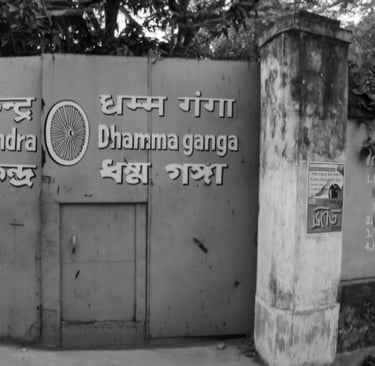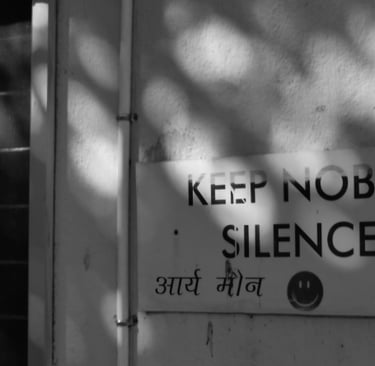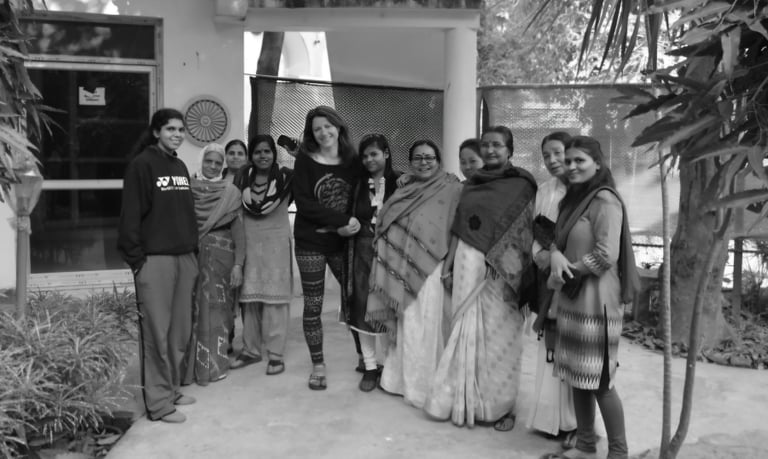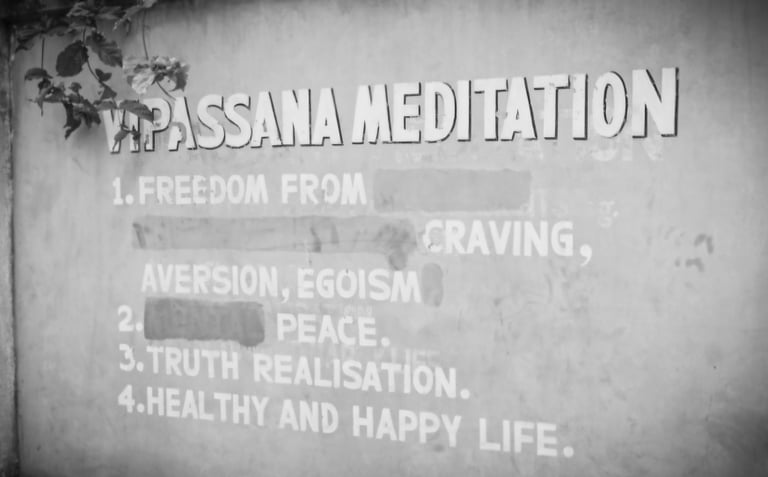How Vipassana Changed My Life
BLOGGING AWAY
How Vipassana Changed My Life
11.03.2025


A Fateful Encounter
There are moments in life that seem to wait in the wings—quiet appointments destined to propel us toward our purpose. Even if their meaning isn’t immediately clear, they create a shift in consciousness that can never be undone.
My encounter with Vipassana meditation was one of those moments.
In 2006, I was living my dream—backpacking across Southeast Asia, embracing spontaneity, reflecting on life, and expanding my perspectives. In Indonesia, I met a fellow traveler who casually mentioned his experience at a 10-day silent meditation retreat in Thailand.
His words sparked a curiosity in me. I thought, What could be more challenging than facing the inner workings of my own mind? I made a mental note—I wanted to experience that one day.
Life’s Detours
After returning to London, where I was studying and working, I slipped into a routine that felt increasingly disconnected from the vibrant, adventurous spirit of my travels. I pursued my studies, navigated career challenges, and dealt with family responsibilities. Nine years went by until a series of losses—the passing of my father and shortly after, my grandmother—forced me to re-evaluate my life. In the midst of grief, I remembered that call to meditation.
I originally intended to attend a silent retreat in Thailand, but fate rerouted me to Kolkata, India, to an S.N. Goenka Vipassana center. I was one of two foreigners there. India itself was a shock, but nothing prepared me for what lay ahead.
The Hardest Experience of My Life
How can I put it.
Vipassana, as taught by S.N. Goenka, is grueling. Days start at 4:30 AM, followed by 10 hours of meditation, no physical exercise except light walking, no reading, no writing, no talking, no phone, no distractions—just you and your mind. The physical pain of sitting cross-legged for hours was unbearable, and boredom gnawed at me.
I approached it all wrong, if there's such a thing. I tried to force my mind into submission, commanding it to focus. Instead, my thoughts became more erratic. My body ached, my mind rebelled, and by day two, I broke down in tears.
I felt like a prisoner of my own dysfunctional mind and wanted to leave. When I confided in my teacher, she told me that crying was a good sign. "Stay," she said. I don't know how, but I did.
Day five was another breaking point. My back hurt, my legs ached, and I couldn’t take it anymore. The teacher allowed me to use a chair, which helped. That small shift gave me the strength to stay.
Days 1 to 4: Meeting the Subconscious Mind
The 10-day Vipassana retreat always starts with three days of Anapana, a technique that involves observing the breath and focusing the awareness on the small triangle between the nose and the upper lip. This allows to sharpen the mind in preparation for the actual practice of Vipassana, which begins on day four.
Vipassana itself is a form of body scanning. We were instructed to move our awareness from the top of the head to the bottom of the feet, observing the physical sensations on the surface of the body.
Something unexpected happened as I entered Vipassana for the first time, I was blown away! I felt the sensations of my body from a place I had never accessed before—the subconscious mind.
I could feel the symphony of life within me: the steady rhythm of my heartbeat, the movements of blood, the intricate interplay of energy coursing through my body. Everything was suddenly very loud—an ecosystem within itself!
How had I never known this before? Why had no one taught me this in school? It felt like the most fundamental truth about being human.
Days 5 to 7: The Emotional Purge
On day five, during a rare session of peaceful meditation, a new phase began. I had been calm, thoughtless, simply present in the moment, practicing Vipassana—at last. Suddenly, a powerful sensation arose in my stomach—an overwhelming wave of anger, literally out of nowhere. My body had stored this anger, and now it surfaced without warning.
The teachings instructed me to remain equanimous—to observe the seansation without reacting. I imagined myself in Hagrid’s home from Harry Potter, welcoming an unwanted guest from an imaginary basement, pouring it a cup of tea, and sitting with it until it was ready to go.
So, I sat with my anger. I let it exist without suppressing or engaging with it. After about an hour, it left.
Then came passion.
It followed the same pattern—arising from the depths, overtaking my trunk area, and then dissipating once I allowed it to be. I would welcome the sensation in Hagrid’s home; it would look like a zombie, and I would pretend I was okay with it. I would offer my zombie tea and sit with it, until it naturally wanted to leave. I wouldn't push it in any ways. Then, I would accompany this particular guest to the door.
Little did I know, that was only the beginning of two and a half days of intense sensations arising and passing inside my stomach—waves of buried emotions emerging, lingering, and then evaporating. In Vipassana, they are called Sankharas—deep-rooted mental impressions.
It seemed like undergoing surgery with minimal anesthesia, as if parts of me were being stripped away while on the operating table. I was weak, focused on the strange workings of my body. In that moment, I understood why noble silence was in place and why even eye contact was frowned upon, that's exactly what I needed.
Then, in the early hours of day eight, the process came to an end, the last emotion evaporated and it wasn't replaced by anything else. I finally perceived lightness in my stomach and in that moment a powerful wave of energy took over my body, expanding my torso from the inside out, radiating warmth. I experienced a state of bliss.
I thought, Am I enlightened now? (Spoiler: I wasn’t.)
And then, the moment I feared losing it, it disappeared. That fear was enough to create new mental defilements. That’s how, for the first time, I saw how the mind works.




Days 8 to 10: The Final Stretch
Days eight to ten were slow, hard, and boring. I was almost at the end, so the idea of leaving didn’t cross my mind, but I couldn’t wait for it to be over, to be honest. I was barely following the rules and practices, struggling to get up in the mornings.
By day ten, I was exhausted but victorious. The clarity in everyone’s eyes was unmistakable—we had all been through something profound.
It was as if a powerful camaraderie had been created. Each of us had come to know the other women at the center simply by observing their silent presence—listening to their sneezes or coughs, noticing their way of walking, or the posture when they sat during meditation. You can tell a lot about someone by the way they meditate in a Vipassana retreat.
I had easily been the center of attention—not only because I was one of the two foreigners there but also because I was the most restless meditator. I looked tormented, moving continuously, wandering around the center wrapped in a thick blanket. All the women wore elegant Indian dresses, their hair were combed. I roamed around in my masculine Western attire, with that thick woolen blanket on and my goofy glasses.
By the end of it, we couldn’t wait to connect. Even without a shared language, we found joy in meeting each other’s eyes, exchanging smiles, and communicating through warm gestures of affection.
Alex, my roommate from the United States, was my lifesaver. I don’t think I would have made it without her. Seeing another Westerner next to me managing the process better than I did was reassuring. If she could do it, maybe I could too.
I couldn’t take notes during Vipassana, but the day I realized I am not my thoughts, and that I am actually free, was December 24, 2015. In my mind, it became ‘Freedom Day’—the day I realized I was not a prisoner of my mind. I vowed to remember it every year.
The Journey Continues
After the incredible experience, I intended to maintain my practice, but I struggled to do so. Over time, Vipassana faded into the background, and meditation became sporadic, if not non-existent.
It wasn’t until 2019, during the most painful breakup of my life, that I briefly turned to Vipassana again for clarity. Then I lost it once more—until another tough moment in 2022.
This time, something in me said, "Enough is enough." I had tried everything external to find happiness, but it wasn’t working. In that moment, I realized that the only alternative was to go inward. And guess what? I already had a tool in my toolbox—Vipassana!
I sat with my pain, just as I had with my emotions years before. I welcomed my suffering, observed it, and allowed it to be. Vipassana quickly transformed into my own version of Body Integration, incorporating shadow work and other practices I had picked up along the way.
I lingered in that space every spare moment I had—for days and weeks. My weekends were spent sitting cross-legged on the sofa or with my legs stretched out in front of me, locked into my subconscious mind. My migraines actually helped me perceive body sensations more clearly, making them the perfect object of observation.
Through this process, I healed—emotionally and physically. More than that, I discovered my purpose: understanding the mind-body connection and working with the subconscious mind and energy.




Coming Home
From a chance conversation in 2006 to a life-changing experience, Vipassana became my gateway to self-discovery. It revealed how the mind works—on an experiential level. It provided both the philosophical background and practical teachings to begin addressing myself and understanding my calling.
What I love most about Vipassana is that it’s taught as a scientific method of self-observation. This was important to me because, at the time I experienced it, I had been agnostic for most of my life. Any spiritual stance or esoteric talk would have completely put me off.
After many years and everything that followed thanks to Vipassana, I am no longer a non-believer or skeptical. I now understand that my life's journey is entirely spiritual. Vipassana and S.N. Goenka form the foundation of my inner life and my work today. I will be forever grateful for this beautiful practice and for the man who brought it to the world in such an accessible way, as it runs on donation basis and virtually anybody can experience it.
Now, I return to India every year—not just as a traveler, but as a seeker. It turns out that Kolkata is my spiritual home, home not only to the Dhamma Ganga Vipassana Center, where I first practiced meditation, but also to two other key figures: Paramahansa Yogananda, my teacher, and Mother Teresa, whose work resonated deeply with me when I had the chance to volunteer there not long ago.
Thanks to Vipassana, every day, I come home—to myself, to my practice.
The journey was long, winding, and filled with detours. But in the end, I arrived exactly where I was meant to be, and I keep walking.
My office
Anywhere in the world
Contact
hello@valeriafontana.com
